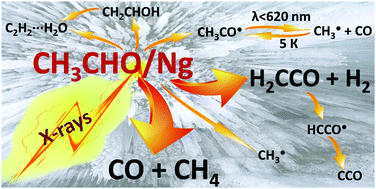Radiation-induced transformations of acetaldehyde molecules at cryogenic temperatures: a matrix isolation study†
Abstract
Acetaldehyde is one of the key small organic molecules involved in astrochemical and atmospheric processes occurring under the action of ionizing and UV radiation. While the UV photochemistry of acetaldehyde is well studied, little is known about the mechanism of processes induced by high-energy radiation. This paper reports the first systematic study on the chemical transformations of CH3CHO molecules resulting from X-ray irradiation under the conditions of matrix isolation in different solid noble gases (Ne, Ar, Kr, and Xe) at 5 K. CO, CH4, H2CCO, H2CCO–H2, C2H2⋯H2O, CH2CHOH, CH3CO˙, CH3˙, HCCO˙, and CCO were identified as the main radiolysis products. The dominant pathway of acetaldehyde degradation involves C–C bond cleavage leading to the formation of carbon monoxide and methane. The second important channel is dehydrogenation resulting in the formation of ketene, a potentially highly reactive species. It was found that the matrix significantly affected both the decomposition efficiency and distribution of the reaction channels. Based on these observations, it was suggested that the formation of the methyl radical as well as vinyl alcohol and the C2H2⋯H2O complex presumably included a significant contribution of ionic pathways. The decomposition of acetyl radicals under photolysis with visible light leading to the CH3˙–CO radical-molecule pair was observed in all matrices, while the recovery of CH3CO˙ in the dark at 5 K was found only in Xe. This finding represents a prominent example of matrix-dependent chemical dynamics (probably, involving tunnelling), which deserves further theoretical studies. Probable mechanisms of acetaldehyde radiolysis and their implications for astrochemistry, atmospheric chemistry and low-temperature chemistry are discussed.



 Please wait while we load your content...
Please wait while we load your content...